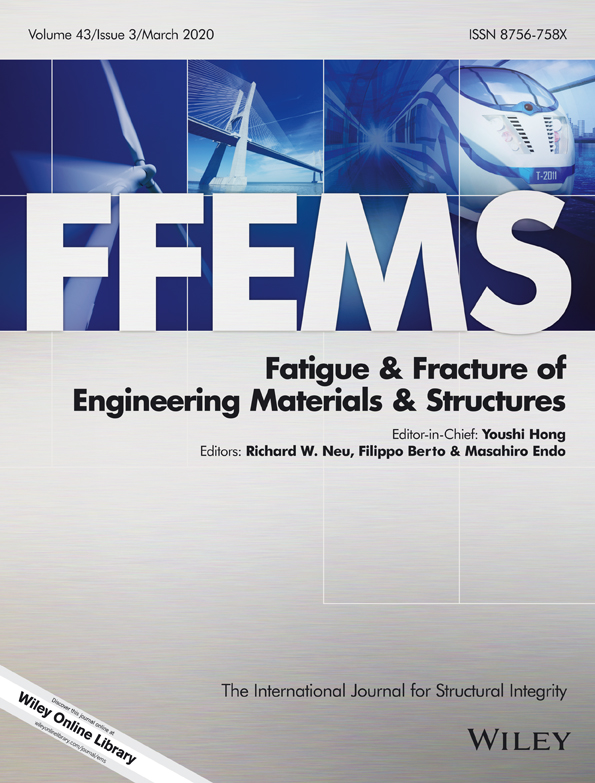A new weight function for one-dimensional subsurface cracks under general loading
Ali Abdoli
Mechanical Engineering Department, Urmia University, Urmia, Iran
Search for more papers by this authorJamal Khezri
Mechanical Engineering Department, Urmia University, Urmia, Iran
Search for more papers by this authorCorresponding Author
Javad Alizadeh Kaklar
Mechanical Engineering Department, Urmia University, Urmia, Iran
Correspondence
Javad Alizadeh Kaklar, Assistant Professor, Mechanical Engineering Department, Urmia University, Urmia, Iran.
Email: [email protected]
Search for more papers by this authorAli Abdoli
Mechanical Engineering Department, Urmia University, Urmia, Iran
Search for more papers by this authorJamal Khezri
Mechanical Engineering Department, Urmia University, Urmia, Iran
Search for more papers by this authorCorresponding Author
Javad Alizadeh Kaklar
Mechanical Engineering Department, Urmia University, Urmia, Iran
Correspondence
Javad Alizadeh Kaklar, Assistant Professor, Mechanical Engineering Department, Urmia University, Urmia, Iran.
Email: [email protected]
Search for more papers by this authorAbstract
In the present study, weight functions (WFs) of a subsurface crack were derived by proposing a new general form for approximate one-dimensional WF. The WFs coefficients were considered as a function of crack length to depth ratio and were obtained using reference stress intensity factors (SIFs) of 16 cracks under uniform, linear, and parabolic normal and shearing loadings. The verification was performed by comparison of the straight and coupled SIFs calculated by WF and finite element modelling under some complicated loadings. In conclusion, the WFs can be simply and effectively employed for evaluating the cracks under any complex stress distributions.
REFERENCES
- 1Ma L, He CG, Zhao XJ, et al. Study on wear and rolling contact fatigue behaviors of wheel/rail materials under different slip ratio conditions. Wear. 2016; 366-367: 13-26.
- 2Mazzu A. A mode II weight function for subsurface cracks in a two-dimensional half-space. Fatigue Fract Eng Mater Struct. 2002; 25(10): 911-916.
- 3Jonesa R, Peng D, Pitt S, Wallbrink C. Weight functions, CTOD, and related solutions for cracks at notches. Eng Fail Anal. 2004; 11(1): 79-114.
- 4Beghini M, Bertini L, Fontanari V. A weight function for 2D subsurface cracks under general loading condition. Eng Fract Mech. 2008; 75(3-4): 427-439.
- 5Yang ST, Ni YL, Li CQ. Weight function method to determine stress intensity factor for semi-elliptical crack with high aspect ratio in cylindrical vessels. Eng Fract Mech. 2013; 109: 138-149.
- 6Zhao XC, Wu XR, Tong DH. Weight functions and stress intensity factors for pin-loaded single-edge notch bend specimen. Fatigue Fract Eng Mater Struct. 2015; 38(12): 1519-1528.
- 7Jin X, Shah S, Roegiers J, McLennan J. Weight function of stress intensity factor for symmetrical radial cracks emanating from hollow cylinder. Eng Fract Mech. 2016; 159: 144-154.
- 8Jin X, Zeng Y, Ding S, et al. Weight function of stress intensity factor for single radial crack emanating from hollow cylinder. Eng Fract Mech. 2017; 170: 77-86.
- 9Ghajar R, Saeidi Googarchin H. General point load weight function for semi-elliptical crack in finite thickness plates. Eng Fract Mech. 2013; 109: 33-44.
- 10Jin Z, Wang X. Weight functions for the determination of stress intensity factor and T-stress for semi-elliptical cracks in finite thickness plate. Fatigue Fract Eng Mater Struct. 2013; 36(10): 1051-1066.
- 11Ghajar R, Alizadeh Kaklar J. Mixed mode weight functions for an elliptical subsurface crack under shear loadings. Eng Fract Mech. 2015; 136: 58-75.
- 12Alizadeh Kaklar J, Ghajar R. Calculation of mixed mode stress intensity factors for an elliptical subsurface crack under arbitrary normal loading. Fatigue Fract Eng Mater Struct. 2015; 38(6): 700-713.
- 13Alizadeh Kaklar J, Saeidi Googarchin H. Approximate stress intensity factors for a semi-circular crack in an arbitrary structure under arbitrary mode I loading. Theor Appl Fract Mech. 2018; 94: 71-83. https://doi.org/10.1016/j.tafmec.2018.01.007
- 14Bao R, Zhang X, Yahaya NA. Evaluating stress intensity factors due to weld residual stresses by the weight function and finite element methods. Eng Fract Mech. 2010; 77(13): 2550-2566.
- 15Mazzu A. A numerical approach to subsurface crack propagation assessment in rolling contact. Fatigue Fract Eng Mater Struct. 2013; 36(6): 548-564.
- 16Kasivitamnuay J. Simplified weight function for calculating stress intensity factor in complicated stress distributions. Eng J-Can. 2015; 20: 49-60.
- 17Gledic I, Parunov J. Application of weight function method in the assessment of crack propagation through stiffened panel. Towards Green Marine Technology and Transport proceedings 2015; Taylor & Francis Group, 247-52.
- 18Wu H, Li L, Chai G, Song F, Kitamura T. Three-dimensional thermal weight function method for the interface crack problems in bimaterial structures under a transient thermal loading. J Therm Stresses. 2016; 39(4): 371-385.
- 19Fett T, Munz D. Stress intensity factors–T-stresses–weight functions. Southampton: Computational Mechanics Publications; 2008.
- 20Bueckner HF. A novel principle for the computation of stress intensity factors. J Appl Math Mech. 1970; 50: 529-546.
- 21Rice J. Some remarks on elastic crack-tip stress field. Int J Solids Struct. 1972; 8(6): 751-758.
10.1016/0020-7683(72)90040-6 Google Scholar
- 22Wang X, Glinka G. Determination of approximate point load weight functions for embedded elliptical cracks. Int J Fatigue. 2009; 31(11-12): 1816-1827.
- 23Alizadeh Kaklar J, Khezri J, Abdoli A. Mixed mode stress intensity factors for a crack parallel to the free surface of a half-plane under uniform loading. Modares Mech Eng. 2018; 18: 219-224. in Persian
- 24Murakami Y. Stress Intensity Factors Handbook. 1st ed. Oxford: Pergamon; 1987.




